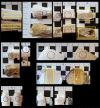A multi-method assessment of 3D printed micromorphological osteological features
- PMID: 35141777
- PMCID: PMC9375746
- DOI: 10.1007/s00414-022-02789-y
A multi-method assessment of 3D printed micromorphological osteological features
Abstract
The evaluation of 3D printed osteological materials has highlighted the difficulties associated with accurately representing fine surface details on printed bones. Moreover, there is an increasing need for reconstructions to be demonstrably accurate and reliable for use in the criminal justice system. The aim of this study was to assess the surface quality of 3D prints (n = 9) that presented with micromorphological alterations from trauma, taphonomy and pathology processes. The archaeological bones were imaged using micro-CT scanning and 3D printed with selective laser sintering (SLS) printing. A multi-method experimental approach subsequently identified: (1) the 3D printed bones to be metrically accurate to within 1.0 mm; (2) good representation of micromorphological surface features overall, albeit with some loss of intricate details, depths, and fine textures that can be important for visual processing; (3) five of the nine 3D printed bones were quantitatively scored as accurate using the visual comparison method; and, (4) low mesh comparison distances (± 0.2 mm) between the original models and the digitised 3D print models. The findings offer empirical data that can be used to underpin 3D printed reconstructions of exhibits for use in courts of law. In addition, an adaptable pathway was presented that can be used to assess 3D print accuracy in future reconstructions.
Keywords: 3D imaging; 3D modelling; 3D printing; Evidence reconstruction; Forensic anthropology; Trauma.
© 2022. The Author(s).
Conflict of interest statement
The authors declare no competing interests.
Figures







References
-
- Blau S, et al. Evaluating the impact of different formats in the presentation of trauma evidence in court: a pilot study. Aust J Forensic Sci. 2018;51(6):695–704. doi: 10.1080/00450618.2018.1457717. - DOI
-
- Baier W et al (2020) Forensic 3D printing from micro-CT for court use—process validation. Forensic Sci Int 110560. 10.1016/j.forsciint.2020.110560. - PubMed
MeSH terms
LinkOut - more resources
Full Text Sources

